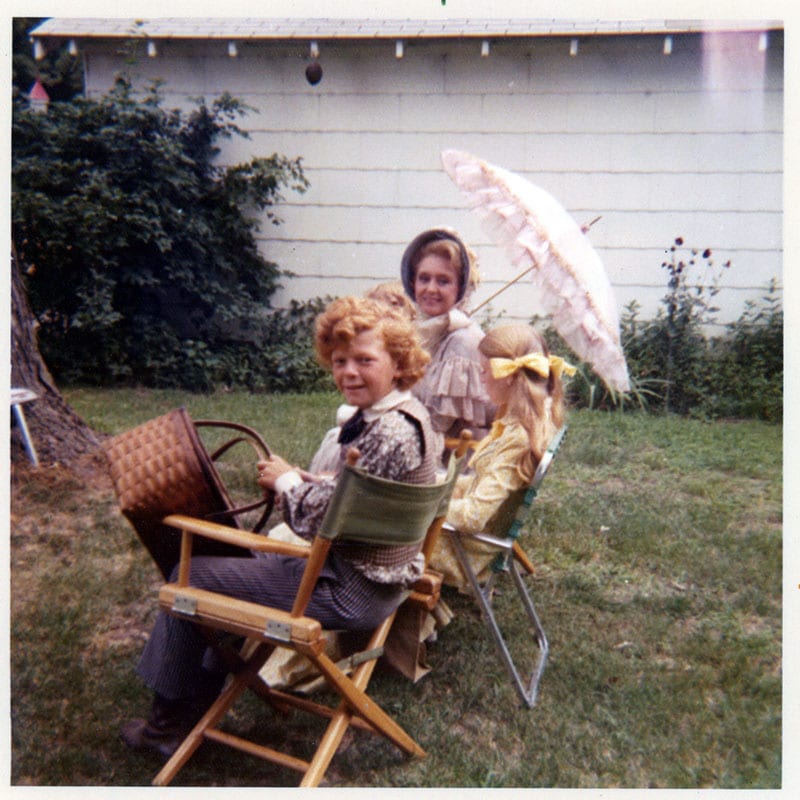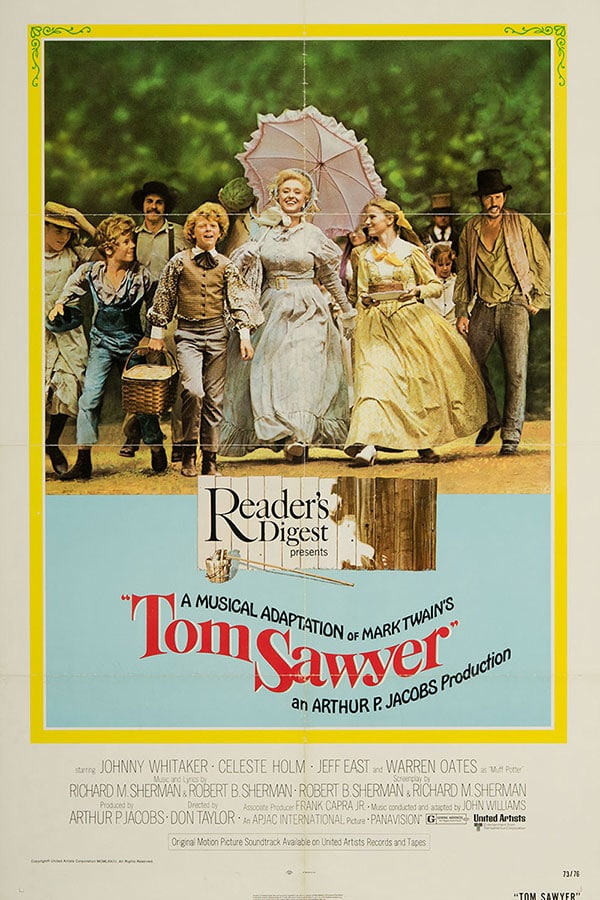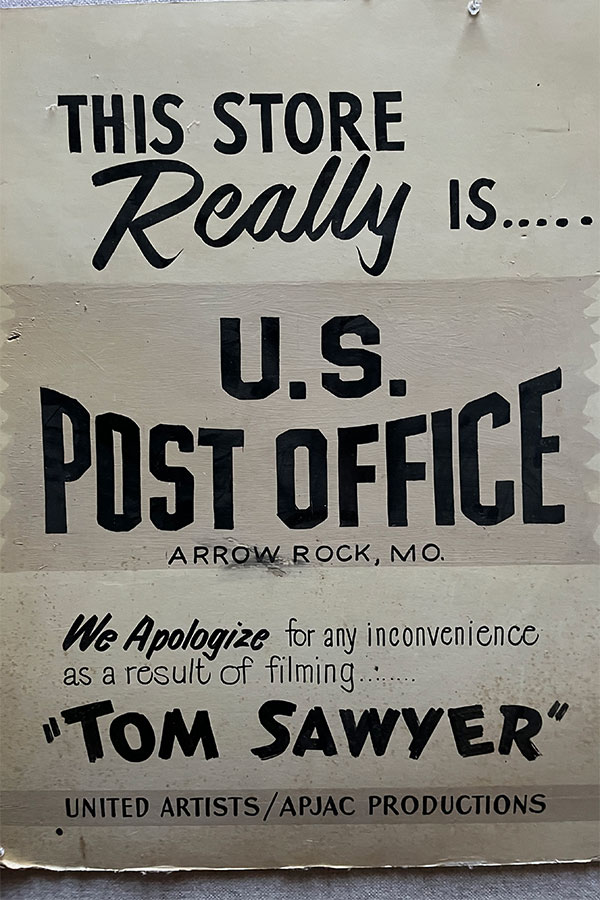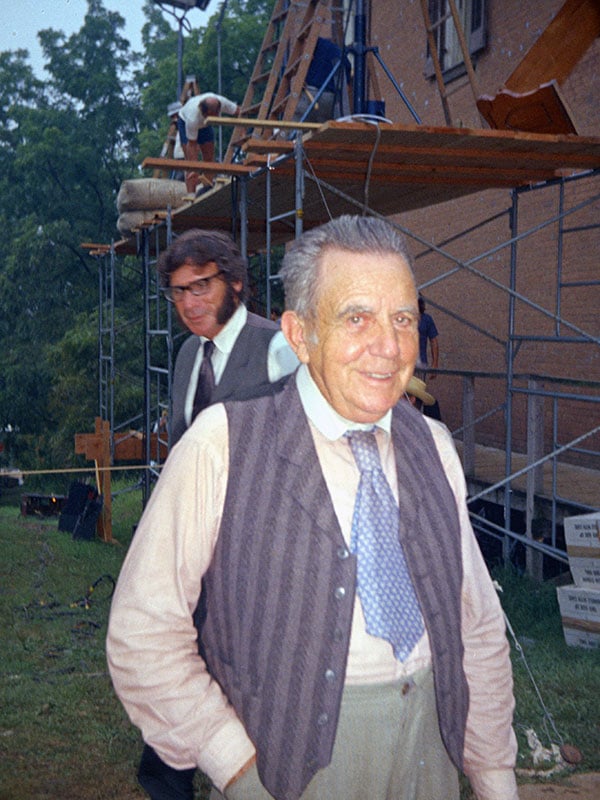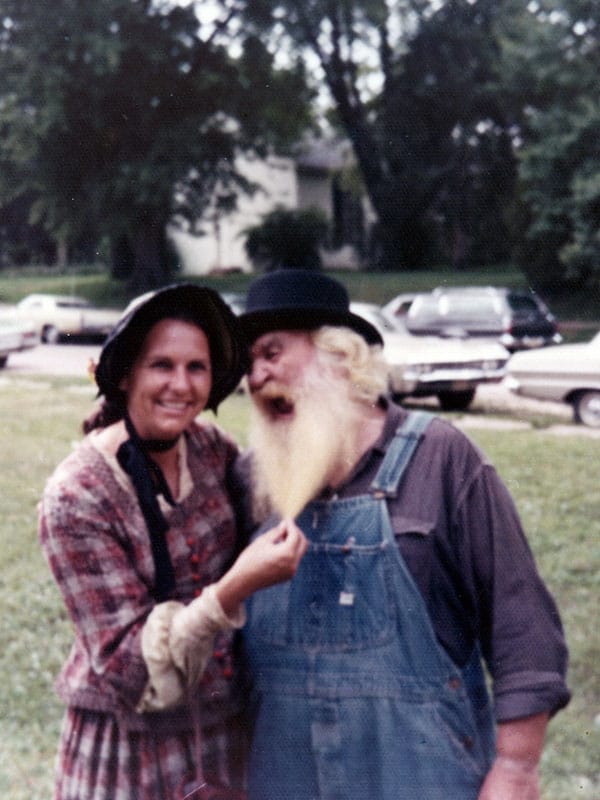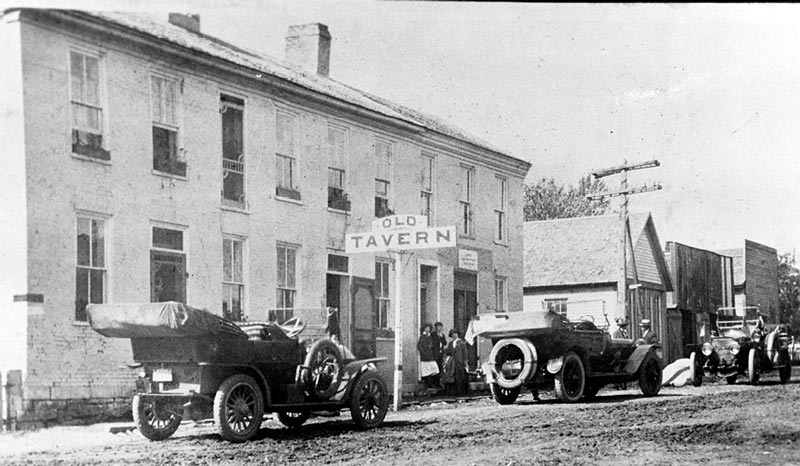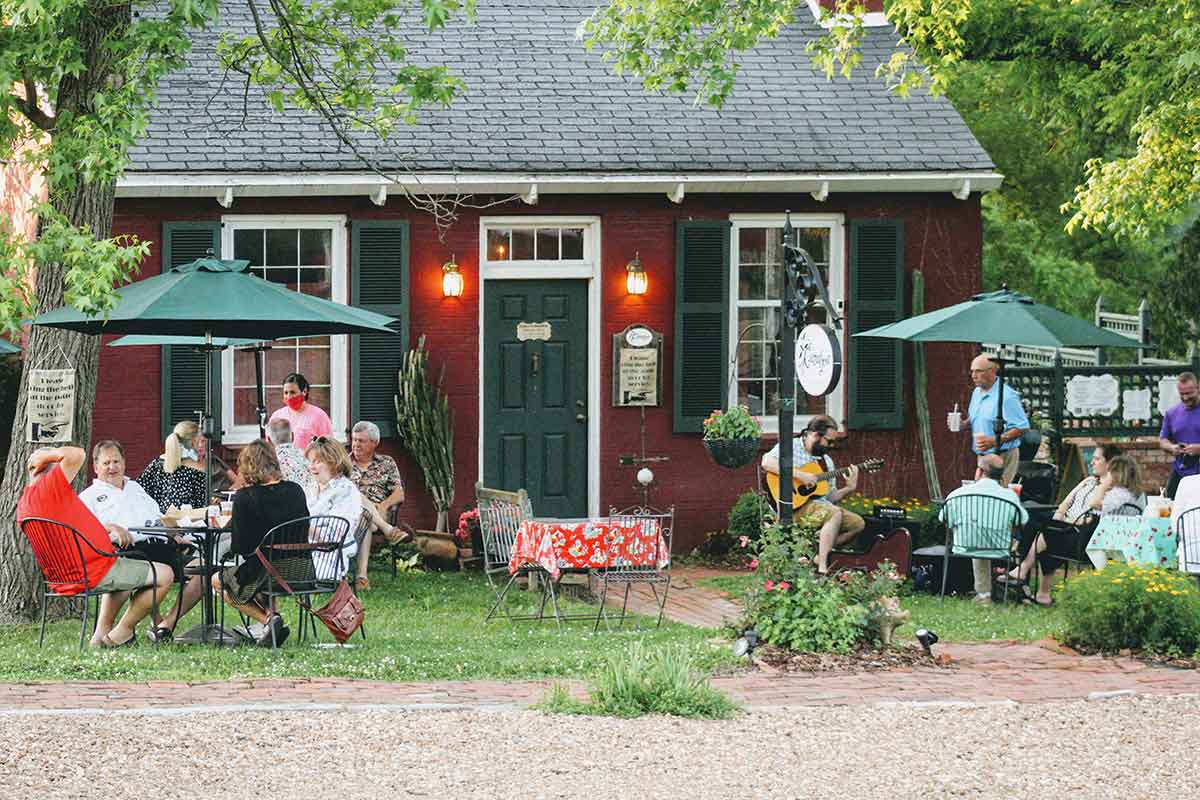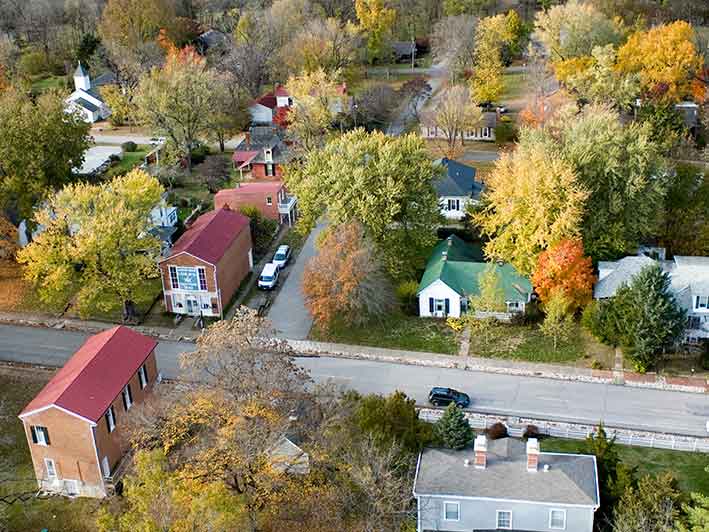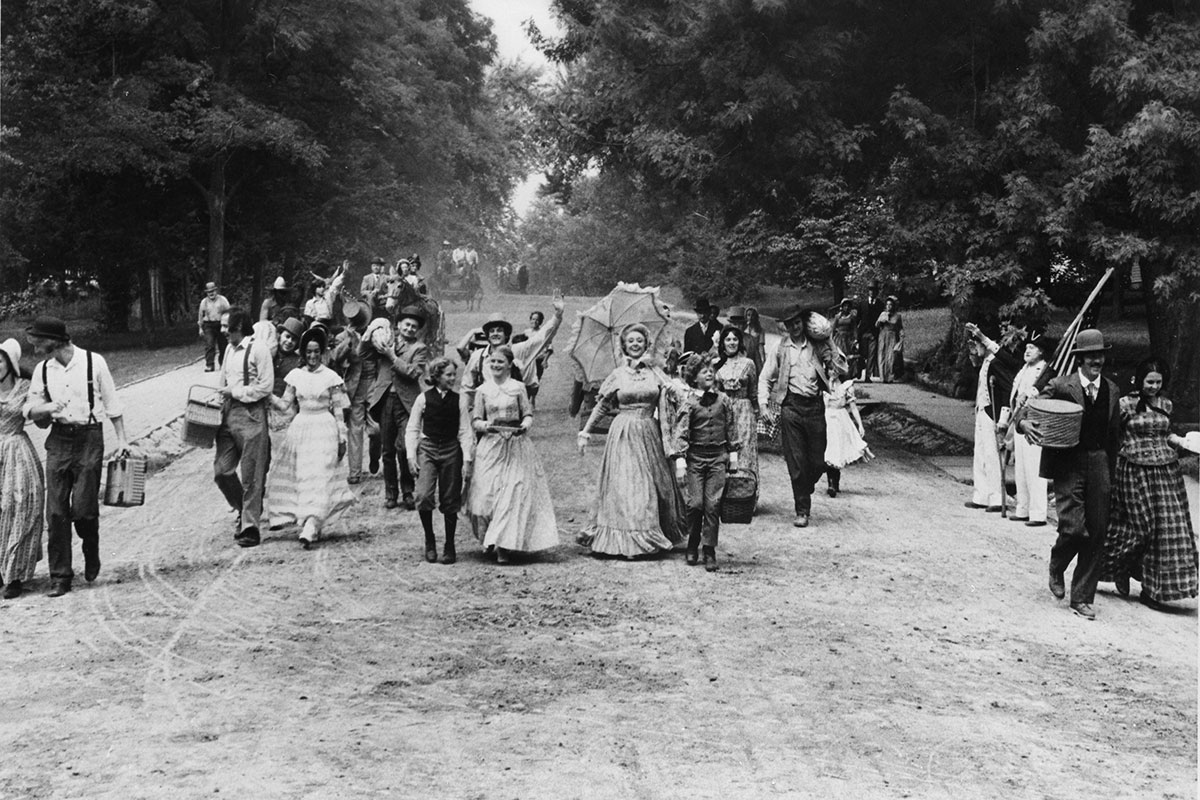
On Arrow Rock’s Main Street, a joyful promenade heads to the film’s Fourth of July picnic during one of the uplifting musical numbers. Dozens of area residents joined the film’s stars for this and other scenes. The film crew removed or hid all signs of modern life before the filming began, added period-correct fences and trucked in dirt to cover the paved streets. Photo — Max Harlynking
Filmmakers found Hannibal in Arrow Rock 50 years ago
This article originally appeared in the June 2022 issue of Missouri Life magazine.
In early September 1971, a letter from Missouri Governor Warren E. Hearnes arrived in the Beverly Hills offices of Arthur P. Jacobs Productions.
It read, in part:
It is our understanding that plans are now being developed for the filming of a musical motion picture centered around The Adventures of Tom Sawyer, and that preliminary site arrangements are being made. It is my pleasure to invite serious consideration of the wide variety of outdoor locations in Missouri, which would be suitable for such a motion picture. Included are numerous cave, forest, and river settings of incomparable beauty. We in Missouri would be pleased to assist in the site selection process and to offer our full cooperation in presenting this state for consideration as the appropriate filming location for a Tom Sawyer movie.
Fifty years ago this summer, that entreaty was accepted. A major Hollywood film company arrived in mid-Missouri for a nine-week shooting schedule to film a widescreen musical adaptation of Mark Twain’s classic 1876 book, The Adventures of Tom Sawyer.
A Family Musical
The 1970s were a tumultuous time in American filmmaking. The old studio system that had carefully guarded the wholesomeness of movies for decades had crumbled, and Hollywood’s titanic film factories were being outpaced by nimble independent producers with lower budgets and more adult story themes.
However, the standout critical and financial success of The Sound of Music in 1965 had been a beacon of hope to the old guard and resulted in an outpouring of film musicals—some hits but more misses. Famed Hollywood showman Arthur P. Jacobs had produced the famous but disappointing Doctor Dolittle in 1967, and the critically acclaimed but commercially lackluster Goodbye, Mr. Chips in 1969.
There were doomsday predictions that the movie would turn Arrow Rock into a tourist trap, attracting hungry developers who would build motels, gas stations, and fast-food restaurants.
Jacobs remained optimistic, however, and with a production supervised by Frank Capra Jr. and United Artists locked in as the distributor, he recruited Reader’s Digest to co-produce an all-new musical film version of Tom Sawyer. In its July 1973 issue, the venerable magazine explained its entry into film production by saying that the company was “guided by the conviction that millions of Americans who no longer go to the movies will again flock to them if presented with intelligent and entertaining films designed to appeal to the entire family.”
Sensing a strong audience appetite for a kind of filmmaking that seemed to have been abandoned by everyone (except Disney, which had taken to churning out inoffensive formulaic comedies like The Million Dollar Duck and The Barefoot Executive), Jacobs and his team set about taking a seemingly paltry $2.5 million budget and using every penny wisely and well. By comparison, hits from the same year, such as The Exorcist and Papillon, had budgets of $12 million, and even a simple romance like The Way We Were cost $15 million.
Movies on the Move
Tom Sawyer joined an increasing number of what were termed “runaway productions,” a filmmaking project filmed outside of the Los Angeles area, based on requirements of the script or benefits to the production values—or to reduce costs. Tom Sawyer was an example of all of these.
One of the keys to the economy of the Tom Sawyer production was the reduction in size and weight of the previously cumbersome Technicolor and Panavision cameras, and the efficient mobility of the filmmaking departments. This was made possible by the creation of the Cinemobile, which were essentially portable film studios purpose-built within streamlined buses.
The New York Times reported at the time, “Each of these multiton diesel behemoths … is a self-contained movie studio with highly compact cameras, lights, sound recorders, sets, kitchens, and dressing rooms. They are replacing the old-fashioned vans … for each type of equipment and thus cutting production costs. A mobile studio cuts down on production costs by speeding the process. Every piece of equipment has its specially designed place in the truck, with individual doors, and hydraulic lifts to move each item into place on the set.”
From Plattsmouth to Arrow Rock
Beyond the budgetary benefits presented by taking a production on location, the ability to shoot top-quality film at a relatively low cost brought a sense of immediacy and authenticity to the visual art of a film. To an increasingly sophisticated audience, studio soundstage and backlot-bound productions had come to seem artificial and cinematically old-fashioned.
An early production scouting report enthusiastically recommended that the on-screen Hannibal should be in Plattsmouth, Nebraska, and touted these attributes: “30 miles out of Omaha, Platte River, two boats, Delta Queen moved to St. Louis can be used for filming, limestone caves.” But the fortunate intervention of Governor Hearnes and Jim Paley, director of the Missouri Tourism Commission, steered the filmmakers to Missouri and, specifically, to the tiny hamlet of Arrow Rock.
“Once a bustling frontier jump-off point for the westward trek on the Santa Fe Trail,” the 1973 Reader’s Digest article reported, “Arrow Rock has stood virtually still for more than a century. … Many fine old buildings from the 1830s and 1840s still stand; key scenes could be filmed in structures whose period authenticity would soothe the sensibilities of the most ardent Twain purist.”
From Arrow Rock to Hannibal
Indeed, according to Donna Huston, a resident of nearby Marshall and an atmosphere player in the film, “The production designer, Philip Jeffries, immediately saw the potential of filming here in Arrow Rock. He walked through the village and was heard to say happily, ‘I don’t have to build any sets!’”
Much of Arrow Rock was actually in pretty rough shape in 1972, when the filmmakers came to look at it. Location scouting photos show a somewhat ragged and unkempt town, but the filmmakers (and many residents) sensed what a remarkable canvas this provided for improvement. A common sentiment among die-hard preservationists is that historic preservation isn’t only about making things pretty, but about taking out what has made a place ugly.
“Arrow Rock is definitely ready for a Hallmark Channel Christmas movie.”
Arrow Rock State Historic Site Director Cindy Imhoff
The unattractive and the anachronistic elements in the town were the first to disappear with the vision of Philip Jeffries and set decorator Robert Vestel (both of whom would receive Oscar nominations for Tom Sawyer). Kansas City Power & Light buried all the electrical lines along Arrow Rock’s Main Street and in areas where the camera might see them. Likewise, MidMissouri Telephone Company took their phone lines underground. Newly installed boardwalks covered concrete sidewalks, including those along the Main Street business blocks.
Most of the village’s paved streets were buried under three inches of dirt, trucked over from the Arrow Rock State Historic Site, for the duration of the filming. Window screens and TV antennae were removed for the sake of authenticity.
A Timeless Town
A few cleanups and coverups notwithstanding, the village appears in the film largely unchanged. Jeffries looked at the lovingly restored two-story house of Page Williams and decided, “That is Tom’s place!” Reader’s Digest reported, “While Mrs. Williams watched apprehensively, technicians swooped in, clamping scaffolding to her walls to hold high-candlepower lighting, adding on a period kitchen, removing all evidence of electrical outlets and fixtures.”
The 1872 Christian Church was a natural setting for the faux funeral of Tom and Huck. The 1868 Odd Fellows Lodge Hall served as the courtroom for Muff Potter’s murder trial (and Injun Joe’s spectacular leap through the window to escape his fate).
The fine Italianate 1845 Aderton House on Main Street was the residence of Judge Thatcher and his precocious daughter Becky, and the business blocks of Main Street got an extensive re-dressing to represent Hannibal of the 1840s. The stately 1837 J. Huston Tavern overlooked the time-traveling town square. Several building owners signed agreements for filming, and residents were asked not to prune, trim, or mow lawns so the art directors could create the proper “untamed” look.
The handful of Hollywood touches that were constructed included a jail cell in the Main Street alley, a blacksmith shop on the Huston Tavern lawn (which also sheltered lighting and production equipment), and Huck Finn’s riverside shanty in Lamine, a few miles south of Arrow Rock. The swimming hole that rinsed off a dozen whitewash-covered boys is at Wildcliff in Blackwater.
Mr. Dobbins’s schoolhouse interior is the Brownlee School on Highway TT. The Sappington Cemetery State Historic Site is where Doc Robinson met his foul end. Hannibal Landing was along the riverbank in Lupus, and the sternwheel steamboat Julia Belle Swain doubled as the River Queen.
Populating a Production
Enhancing this visual authenticity was the filmmakers’ use of dozens of real residents as the Hannibal townsfolk, dressed in Oscar-nominated period costumes by DonFeld, They were instructed, as Donna Huston recalls, “Don’t wear even a touch of modern make-up!”
There isn’t a hint of Hollywood artifice in the human atmosphere of the film, which is especially important in critical scenes such as a courtroom trial, a funeral, and a joyous summer picnic.
Locals from all over the region took on small roles or served as extras. Jim Kuhn of Glasgow, who for four decades served as that town’s Santa Claus, was the distinctive, white-bearded blacksmith. Page Williams played, with memorable aplomb, what in a family film is called a “saloon girl.” Arrow Rock Mayor Bill Miller played the court clerk, and avid regional thespian Mary Burge was in the church congregation at the funeral, which was presided over by Reverend N. C. Schulz, the minister of the Arrow Rock United Church of Christ.
It was hardly 15 minutes of fame for the locals, but it gave them a chance to interact with stars that included Celeste Holm (Aunt Polly), Warren Oates (Muff Potter), Johnny Whitaker (Tom Sawyer), Jeff East (Huckleberry Finn), and a young Jodie Foster in her first major film role as Becky Thatcher.
The film’s cast and crew were in Arrow Rock from mid-July to the first week of September. It was blazingly hot that summer, with temperatures often reaching 120 degrees in the sets created inside the real buildings. The medical reports on file in the Arthur P. Jacobs Collection at Loyola Marymount University recount the most prevalent (and still familiar) on-set issues: mosquitoes, chiggers, poison ivy, and dehydration.
In addition, the first few weeks saw an inordinate number of foot injuries that diminished as the summer went on—and the barefoot kids toughened their feet and became more experienced at navigating a summer without shoes. But few of the eyewitnesses complain about those circumstances without a fond smile.
A True Family Film
“It was a lot of work,” Donna Huston remembers. “But it was more like a summer picnic or a family reunion. Several of the cast and crew had their children along. I was going to host a dinner party and Celeste Holm overheard and asked, ‘Am I invited?’ Imagine! This Broadway star and Academy Award-winner wanted to join us! The Hollywood kids played with the local kids, and I think there may have been a few summer romances, too,” Donna says with a smile and a wink.
Warren Oates struck up a friendship with local farmer Bill Burge, and the pair became fishing buddies for the duration of the filming.
“Even in its making, the film was a family affair,” says Reader’s Digest. “The cast and crew were encouraged to bring kids, parents, and wives on location, and most of the children served as extras. … When everyone assembled at night to view the day’s shooting, it seemed almost like the old days when a family went out to the movies together.”
An Unforgettable Summer
Part of the agreement with the film company was that the changes they made to Arrow Rock would be undone. The village leaders, however, had no real desire to undo everything. Aderton House retained its “movie fence,” which remains to this day, from its role as the Thatcher home. The wood boardwalk installed on Main Street for the film has become an Arrow Rock icon, the concrete sidewalks underneath long forgotten.
But never forgotten in Arrow Rock will be that magical summer, and the impact on the community when Hollywood found Hannibal in this quaint village. Indeed, there are many who feel that the influence of Tom Sawyer stimulated ongoing preservation. There were doomsday predictions that the movie would turn Arrow Rock into a tourist trap, attracting hungry developers who would build motels, gas stations, and fast-food restaurants.
“Instead, I think that everyone was surprised that the opposite result occurred,” Arrow Rock Lyceum Theatre Producing Artistic Director Quin Gresham says. “It seems as if residents finished that overwhelming summer film shoot and looked around—and realized the treasure they had to protect. I’m frankly surprised we haven’t seen more film production here. We’ve done such a great job of keeping the ‘set’ in good shape.”
Arrow Rock State Historic Site Director Cindy Imhoff agrees, “Arrow Rock is definitely ready for a Hallmark Channel Christmas move.”
Related Posts
April 9, 1917
On this date in Missouri history, the State Park Fund is created to develop Missouri state parks.
A Complete 180 at Catalpa in Arrow Rock
Catalpa in Arrow Rock transforms during the COVID-19 pandemic.

